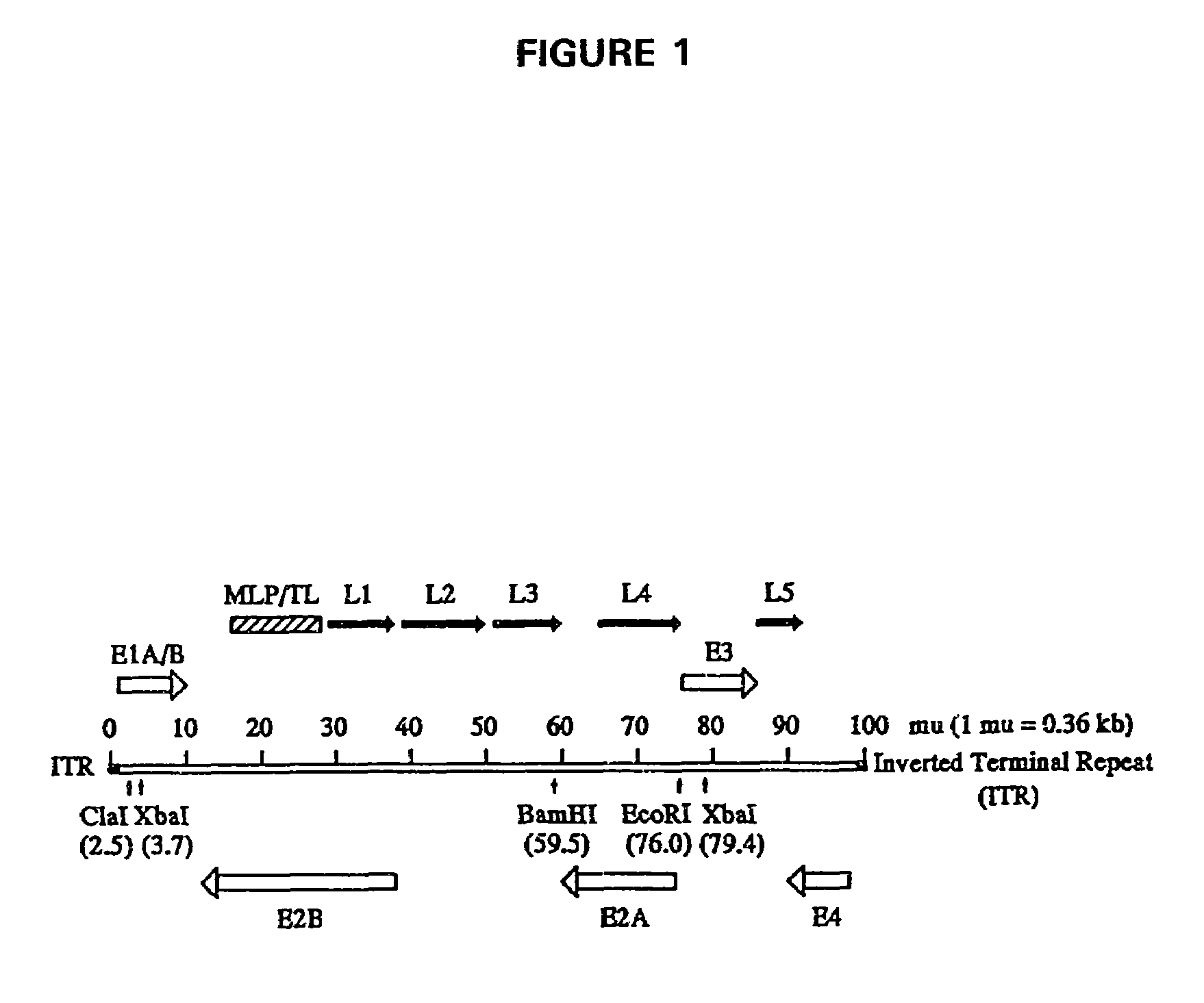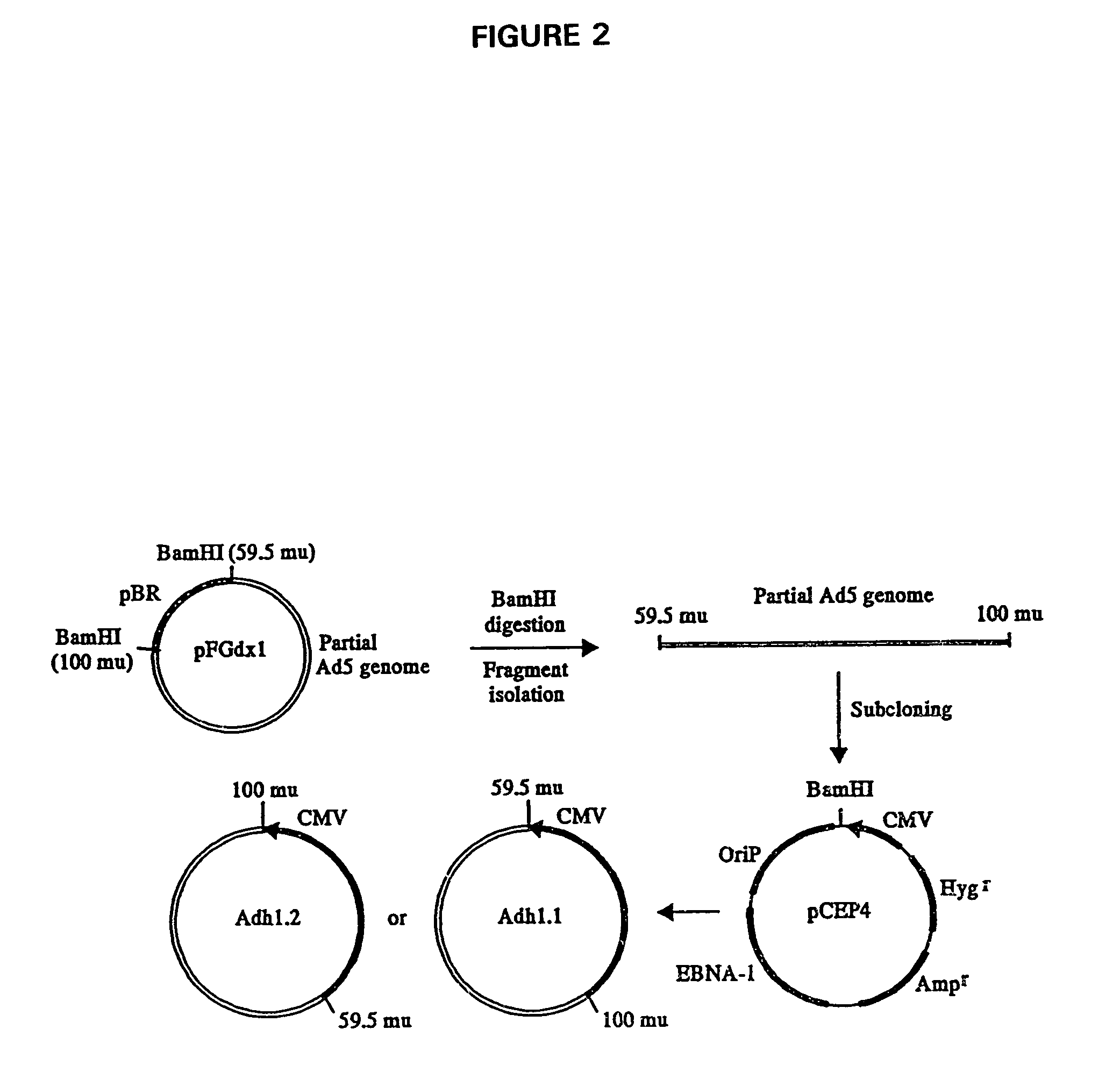Adenovirus supervector system
a technology of adenovirus and supervector, which is applied in the field of viral vectors, can solve the problems of inability to replace lost or defective gene function in vivo, current available gene transfer vectors are not able to meet the requirement of high therapeutic index, and no vector of such a high therapeutic index is currently available, so as to minimize the cytotoxicity of vectors and the capacity of carrying
- Summary
- Abstract
- Description
- Claims
- Application Information
AI Technical Summary
Benefits of technology
Problems solved by technology
Method used
Image
Examples
example 1
Plasmid pCEP4 Vector Transfected Cells
[0066]The vector to be used for the stable expression of the partial Ad genome must meet certain technical requirements such as high genetic carrying capacity, high copy number, and long term expression. One such vector is an Epstein-Barr virus-based eukaryotic expression vector, pCEP4 (Invitrogen Corp., San Diego, Calif.). This vector has the Epstein-Barr viral nuclear antigen (EBNA-1) and origin of replication (oriP) and exhibits high-copy episomal replication and produces high levels of recombinant proteins in a wide range of mammalian cells (Yates, et al., 1985; Su, et al., 1991). This vector also comprises the hygromycin resistance gene for clonal selection and stable maintenance of the vector in cells.
[0067]A 14.6-kb DNA fragment (59.5-100 mu with E3 deleted) that covers the intact E4 and L5 regions of the Ad5 genome was isolated from the plasmid pFGdx1 (Haj-Ahmad and Graham, 1986), which was kindly provided by Dr. Frank L. Graham at McMas...
example 2
Complementation of the E4 Gene
[0068]The pAdh1 vectors described in Example I contain the entire E4 and L5 regions from an Ad5 genomic fragment and are expected to complement Ad mutants with deletions or mutations in those regions of the genome. Functional assays were designed to examine whether the cells could support the propagation of the Ad5 E4 deletion mutant, H5dl1011 (Bridge, et al., 1993), kindly provided by Dr. Gary Ketner at Johns Hopkins University, Baltimore, Md. The selected clones were treated with the H5dl1011 virus at a multiplicity of infection (moi) of 5. The cytopathic effect of Ad was used as an indicator for the propagation of the virus in the clones. It was shown that the clones of the Vero cells that contained the pAdh1.1 vector (referred to as V1.1 cells) were capable of supporting the propagation of H5dl1011. The clones of the Vero cells that contained the pAdh1.2 vector (referred to as V1.2 cells) could not support the propagation of H5dl1011, nor could the ...
example 3
Construction of the Ad5E2 Expression Vector
[0070]The Ad5E2 expression vector was designed so that the E2 promoter activation would be dependent on the E1 proteins provided by the host cells and the E4 proteins encoded by the supervector. Therefore, the vector contains no additional promoter for the E2 fragment.
[0071]The first step in the construction of the Ad5E2 vector was the preparation of the Ad5 E2 fragment (9.2-79.4 mu). The 9.2-76.0 mu fragment isolated from Ad5CMV-p53 DNA was first subcloned into the pBluescript (Stratagene Corp., San Diego, Calif.) derived plasmid designated pWZ-5 (FIG. 5). The 76.0-79.4 mu fragment was isolated from the plasmid pFGdx1 (Haj-Ahmad and Graham, 1986) and inserted into the pWZ-5 plasmid that already contained the 9.2-76.0 mu fragment. The resulting construction was designated pWZ-6 by the inventors and comprised the 9.2-79.4 mu E2 fragment in a pBluescript backbone (FIG. 5).
[0072]The second step was the preparation of the modified pCEP4 vector,...
PUM
| Property | Measurement | Unit |
|---|---|---|
| concentration | aaaaa | aaaaa |
| length | aaaaa | aaaaa |
| size | aaaaa | aaaaa |
Abstract
Description
Claims
Application Information
 Login to View More
Login to View More - R&D
- Intellectual Property
- Life Sciences
- Materials
- Tech Scout
- Unparalleled Data Quality
- Higher Quality Content
- 60% Fewer Hallucinations
Browse by: Latest US Patents, China's latest patents, Technical Efficacy Thesaurus, Application Domain, Technology Topic, Popular Technical Reports.
© 2025 PatSnap. All rights reserved.Legal|Privacy policy|Modern Slavery Act Transparency Statement|Sitemap|About US| Contact US: help@patsnap.com



